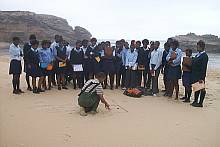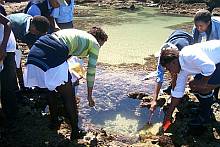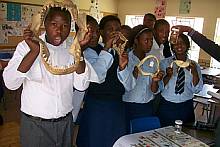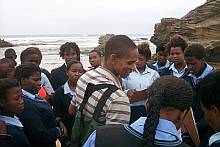ELWANDLE LiMPETS trained to watch over fragile coastline
|
- By Dumile Tshingana, Education Outreach Officer, SAEON Elwandle Node
The shores and estuaries of the Eastern Cape are amongst the most diverse and productive ecosystems in South Africa.
Despite their ecological significance and conservation status, these habitats are being increasingly impacted by human activities - directly by harvesting and trampling, and indirectly through pollution and litter.
Compounding the problem along these shores are issues such as global warming and climatic disruptions that could generate change in the biota.
Monitoring these habitats within the coastal environment is therefore critical to evaluating the health of these diverse systems. But how does one monitor such an extended coastline?
Enter the SAEON Elwandle Node and its ELWANDLE LiMPETS, a long-term monitoring project and experiential training for learners. This innovative experimental approach to schoolyard long-term coastal monitoring was recently launched at Kenton-on-Sea in the Eastern Cape.
With this pilot programme, the Elwandle Node is hoping to implement the monitoring programmes on a regional basis and gradually expand them to other areas of the South African coastline as sites are identified and learners engaged to permanently set aside these territories for long-term monitoring.
It is envisaged that the programme will introduce the learners to the bigger picture of what is happening to the coastal environment outside their schoolyards, and link these observations to their school curriculum. The field activities of the programme are supported by classroom-based exercises which reinforce the syllabus concepts.
How does it work?
The schoolyard long-term ecological research (LTER) and monitoring programme is an in-depth environmental science outreach and monitoring exercise designed to provide learners and educators with the opportunity to experience the scientific process first-hand.
It also provides a platform for school educators to be professionally developed. Teacher support is a key element of the initiative as it is regarded as an important investment in a knowledge resource.
In this pilot project, learners actively participate in the monitoring project to survey key invertebrate species at one of the established rocky shore monitoring sites in the Bushmans River Mouth, looking at the tidal patterns, identifying fish and other marine organisms in the rocky shores, testing the pH of the water, salinity and turbidity. Intertidal monitoring is done during low tides. Transects and quadrants are used to survey and measure the species abundance and distribution along vertical transects on the rocky shores.
Who participates in the programme?
The Elwandle long-term monitoring project and experiential training for learners has been implemented at the Ikamvalesizwe, Nompucuko and Kuyasa Combined Schools in Kenton-on-Sea and Port Alfred. The programme targets learners in grades 9, 10 and 11.
Another project that is being planned is coastal weather observation, for which weather stations are to be erected inside the schoolyard. This project will largely depend on the availability of weather observation kits and data collection tools. Learners and educators will be collecting data over an extended period of time until they are able to identify trends (an overall picture of weather fluctuations).
This data will also be translated into a school syllabus in the form of graph interpretation and charts. Using wireless weather stations, elements such as wind force and direction, precipitation, temperature, sunshine, visibility and cloud cover will be observed. Other tools that will be used for observation and monitoring include a rain gauge, wind sac, anemometer, barometer and tide clocks.
Why participate in this monitoring programme?
When learners are introduced to the Elwandle LiMPETS programme, they learn why monitoring is important, they learn to identify the organisms that are surveyed in the field, and they learn to practice the protocols of monitoring in the classroom using graphs, field guides, quadrants and other learner support material such as posters and text books.
The Elwandle Node recommends that learners are given the opportunity to explore their monitoring sites and practice the monitoring techniques at least once before the actual monitoring starts. The reason for this is that monitoring is an ongoing exercise and needs to be properly done right from the start.
The programme offers an in-depth and unique approach to learning and understanding the basic ecology and environmental issues in the form of political, social, economic and biophysical concerns. Through research-based monitoring, learners develop problem-solving skills, gain experience in using tools and methods employed by field scientists, and learn to analyse data.
In addition, learners contribute to a long-term data set used to identify changes in the abundance and distribution of species over time in these coastal ecosystems. This project incorporates natural science, life sciences, physical science and mathematics. The activities are curriculum-driven.
Back at school, learners learn to analyse and interpret their data and, in addition, are encouraged to share their results with other learners.
Why monitor rocky shores, sandy shores, estuaries and weather patterns?
These ecosystems support some of the richest and most diverse coastal biota in South Africa, yet they are subject to constant changes, largely from human-induced causes.
At some sites, especially in the Eastern Cape, harvesting and trampling have resulted in dramatic decreases in the abundance and diversity of the biota. The accessibility of these ecosystems has led to more and more people visiting them for a variety of recreational activities. The human footprint on our rocky shores and estuaries may lead to unpredictable changes.
Moreover, by their nature, these ecosystems are exposed to many of the pollutants produced by human society. Contaminants released into the air fall onto the surface of the sea and are carried to the seashore, as are chemical contaminants such as oil spills from ships. Waste materials dumped on the land are washed into the sea across the shore, some of it remaining there for years.
The animals and plants which inhabit rocky shore ecosystems may be affected more severely by human activities than those in most other parts of the sea. Fortunately, because of their accessibility, they may also be the easiest to monitor and observe, and hence can serve as marine outdoor classrooms to educate the next generation in sustainable harvesting practices and conservation.
The SAEON Elwandle Node believes in the importance of observing and tracking marine organisms over time. The Schoolyard monitoring programme will provide long-term data that can be used to track changes. Simultaneously, it will introduce our learners to the rich biota of our coast, contributing to a group of well-informed, concerned citizens who will keep watch over these fascinating ecosystems in the future.
For more information about the programme, contact Dumile Tshingana
Related content: SAEON in the Media














